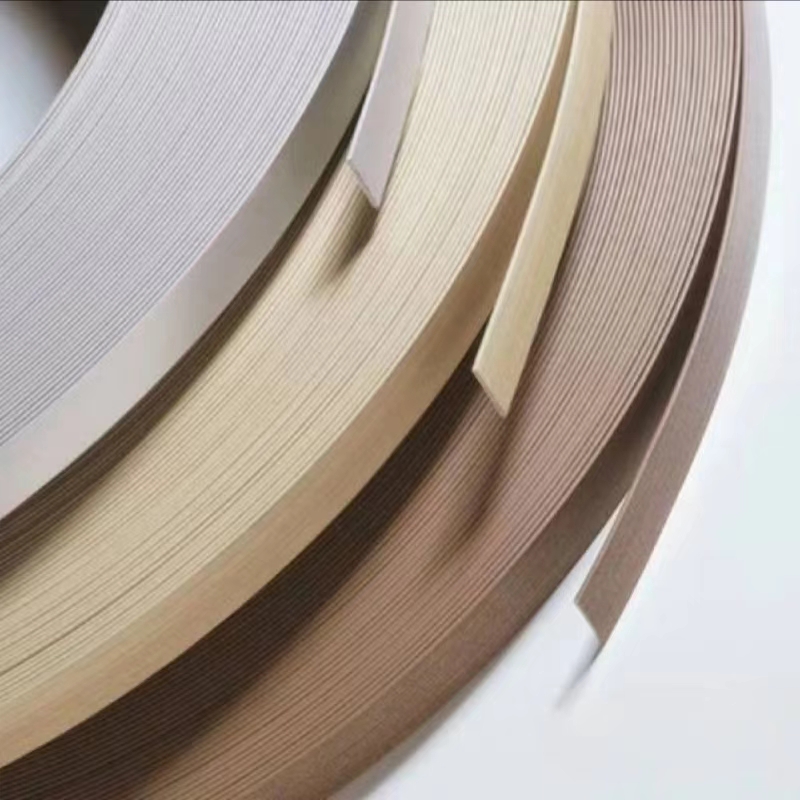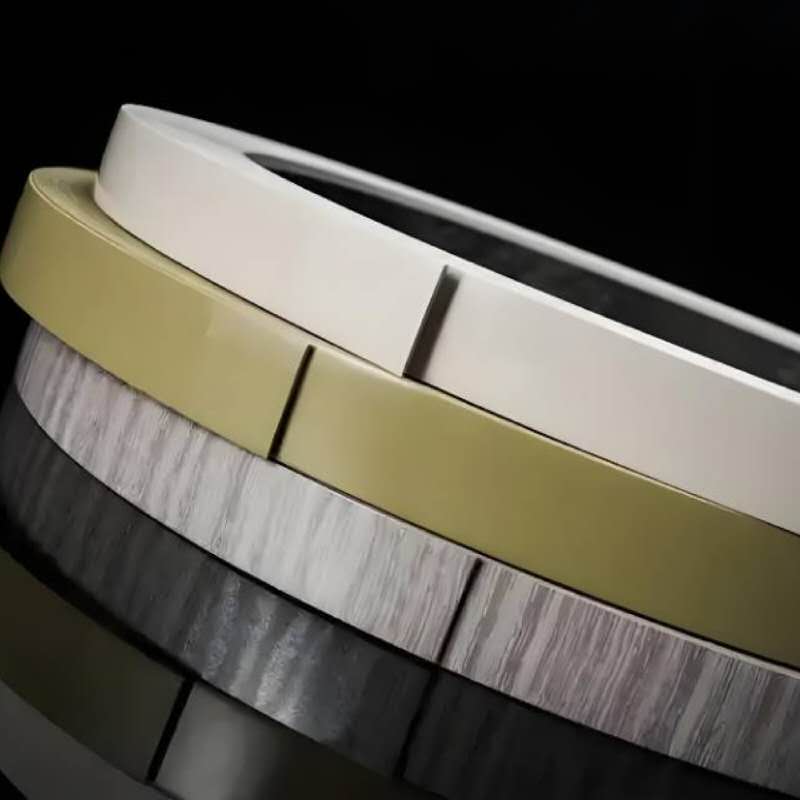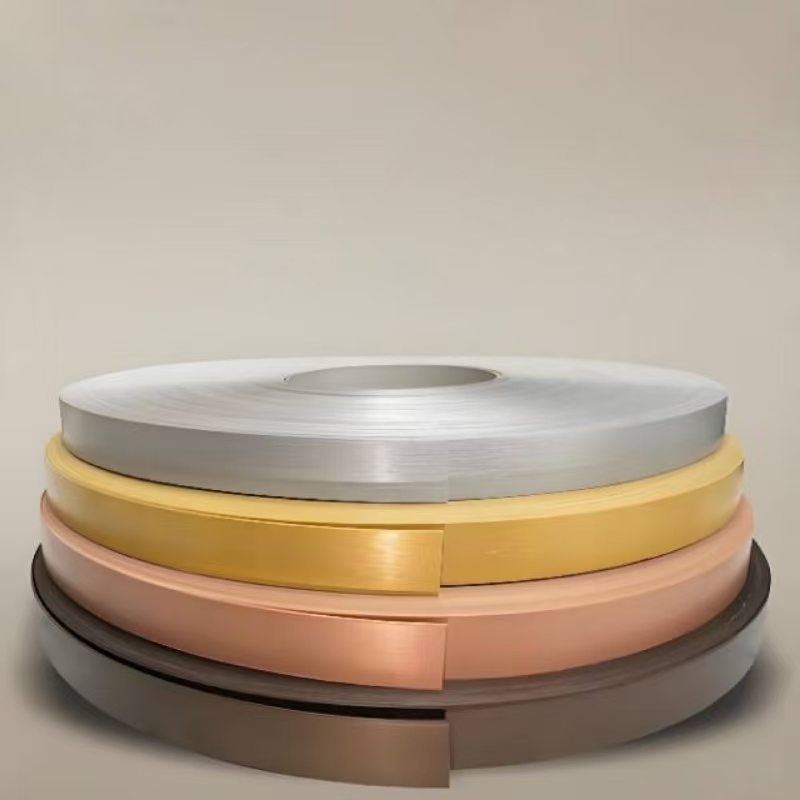Edge banding, as an important part of modern home furnishing and furniture manufacturing, is widely used in the edge modification and protection of wood products. Edge banding not only improves the aesthetics of furniture, but also effectively extends its service life and prevents damage or water absorption to the edges of wood. Edge banding materials vary, and different types of edge banding are suitable for different manufacturing and decoration needs.
Depending on the material, edge banding can be divided into several types, among which the most common are PVC edge banding, Abs edge banding and wooden edge banding. This article will deeply analyze the characteristics, advantages and disadvantages and applicable scenarios of these three edge bandings to help consumers and manufacturers make more reasonable decisions when choosing edge banding.

What are the three types of edge banding?
Three types of edge banding:
1. PVC edge banding
2. Abs edge banding
3. Wooden edge banding
1. PVC edge banding
1.1 What is PVC edge banding?
PVC edge banding is one of the most common types of edge banding. PVC, or polyvinyl chloride, is a widely used plastic material with good chemical stability, weather resistance and corrosion resistance. PVC edge banding is usually made of raw materials such as PVC resin, stabilizer, plasticizer, filler and pigment. Due to its strong plasticity, low cost and rich color and texture selection, PVC edge banding has become the first choice of many furniture manufacturers.
1.2 Characteristics of PVC edge banding
● Durability: PVC edge banding has good durability and can effectively resist the erosion of moisture, oil and chemicals. Its high hardness can effectively prevent damage to the edges of furniture.
● Easy processing: PVC material is easy to process and suitable for large-scale production and application. Its molding and bonding process is simple, and it can be firmly combined with wood by hot pressing, hot melting and other methods.
● Cost-effectiveness: The production cost of PVC edge banding is relatively low, suitable for the mid- and low-end markets. It is widely used in many standard furniture and daily necessities.
● Color and surface decoration: PVC edge banding can achieve various colors and texture effects through different processing techniques such as printing, embossing, coating, etc., providing a variety of choices.
1.3 Disadvantages of PVC edge banding
Although PVC edge banding performs well in many aspects, it also has some shortcomings:
● Environmental issues: PVC materials contain chlorine, which may release harmful gases during production and use, especially in high temperature environments. This makes PVC edge banding face certain market challenges today as environmental awareness gradually increases.
● Poor high temperature resistance: PVC edge banding has relatively poor high temperature resistance and is prone to softening or deformation in high temperature environments, so it is not suitable for use in places with high temperature or direct sunlight.
● Easy to age: PVC materials are prone to aging when exposed to sunlight or moisture for a long time, causing color fading or brittleness.
1.4 Application areas
PVC edge banding is widely used in home furniture, office furniture, cabinets, doors and windows, etc., especially in price-sensitive markets, it is the most popular choice. PVC edge banding is particularly suitable for low-end and mid-range home products due to its durability and cost-effectiveness.

2. Abs edge banding
2.1 What is Abs edge banding?
Abs edge banding is another common type of edge banding. ABS (Acrylonitrile-Butadiene-Styrene) is a strong and durable plastic material that is widely used in various industrial fields. Compared with PVC edge banding, Abs edge banding has certain advantages in strength, high temperature resistance, UV resistance and environmental protection performance.
2.2 Characteristics of Abs edge banding
● High strength: Abs edge banding has high impact resistance and can withstand large external force impact without breaking or deforming easily. This makes it perform well in some furniture with high durability requirements.
● High temperature resistance: Unlike PVC edge banding, Abs edge banding has good high temperature resistance, can maintain stable performance at higher temperatures, and is not easy to deform or soften.
● UV resistance: Abs edge banding has strong resistance to UV rays. When exposed to sunlight for a long time, the surface is not easy to fade or age, which makes Abs edge banding suitable for use in environments with direct sunlight.
● Environmental protection: ABS material does not contain chlorine and does not release harmful gases during the production process, so it has strong environmental protection. It meets the requirements of modern environmental protection regulations and can be recycled, which is in line with the trend of sustainable development.
2.3 Disadvantages of Abs edge banding
● High cost: The production cost of ABS material is relatively high, so the price of Abs edge banding is usually higher than that of PVC edge banding. For consumers with limited budgets, other more cost-effective options may be considered.
● Processing difficulty: Although Abs edge banding has good processing performance, compared with PVC, ABS material has higher processing requirements and may require more sophisticated equipment and processes to achieve the best results.
● High surface treatment requirements: Although the surface of Abs edge banding is relatively smooth, in order to achieve the best decorative effect, more surface treatment processes such as painting, printing or embossing may be required.
2.4 Application fields
Abs edge banding is widely used in high-end furniture, automotive interiors, kitchen supplies and other fields with high requirements for durability and appearance. Its high temperature resistance and UV resistance make it particularly suitable for outdoor furniture and sun-exposed environments. Due to its higher cost, Abs edge banding appears more in mid-to-high-end products.

3. Wood edge banding
3.1 What is wood edge banding?
Wood edge banding is another common edge banding material. It is usually processed with the same or similar wood as the furniture itself, with natural wood grain and elegant appearance. The natural beauty of wood edge banding makes it the first choice in high-end custom furniture and decoration projects. Compared with PVC and Abs edge banding, wood edge banding is more in line with natural and traditional aesthetic requirements.
3.2 Characteristics of wood edge banding
● Natural beauty: Wood edge banding retains the texture and color of natural wood, giving people a warm and natural feeling. Whether it is traditional style furniture or modern minimalist style design, wood edge banding can complement other wood materials and add to the overall beauty.
● Adjustability: Wooden edge banding has strong customizability and can be adjusted according to different wood types and decoration requirements. For example, wooden edge banding can be matched with different types of wood to achieve the best decorative effect.
● Environmental protection: Wooden edge banding is a natural material with good environmental protection. Compared with PVC edge banding, wooden edge banding does not release chemical components and will not pollute the environment.
● Processing performance: Wooden edge banding can be processed by cutting, grinding, coloring and other processes through precise processing methods to adapt to designs of different forms and requirements.
3.3 Disadvantages of wooden edge banding
● Poor durability: The durability of wooden edge banding is usually not as good as PVC and ABS edge banding, especially in humid or high temperature environments, wooden materials are prone to moisture deformation, cracking or mold.
● Higher cost: The production cost of wooden edge banding is usually high, especially the choice of high-grade wood, so it is also more expensive than PVC and ABS edge banding in price.
● High maintenance requirements: Wood edge banding may require regular maintenance and care to maintain its appearance and performance. This may add additional maintenance costs and workload for busy families or commercial users.
3.4 Application areas
Wood edge banding is often used in high-end custom furniture, classical style home decoration and some products that require natural beauty. Due to its natural beauty and unique texture, wood edge banding occupies an important position in home decoration and wood product manufacturing, especially in luxury decoration and high-end furniture design.
As an important part of furniture and wood products, different types of edge banding have different performance characteristics and applicable scenarios. PVC edge banding is suitable for most daily home and office furniture products due to its low cost and wide application; Abs edge banding is suitable for mid-to-high-end products due to its excellent durability and environmental protection; and wood edge banding has become the first choice in high-end custom furniture and decoration projects due to its natural beauty and environmental protection characteristics.

Where to Buy High-Quality PVC Edge Banding at Low Prices?
If you are searching for affordable and high-quality PVC edge banding, look no further than Tingjie, a professional China-based supplier. Our factory-direct prices and customized edge banding solutions make us a top choice for furniture manufacturers, wholesalers, and distributors. We supply edge banding in various colors, thicknesses, and finishes to meet diverse market needs. Our products are widely used in cabinetry, furniture panels, and interior design applications.




